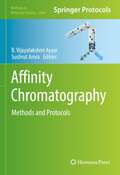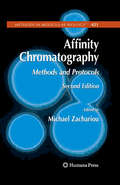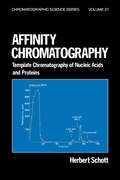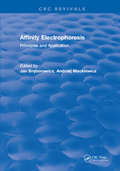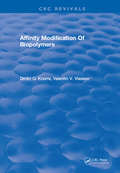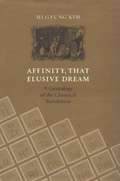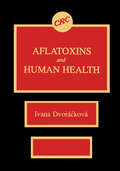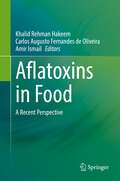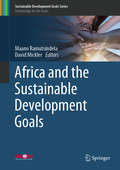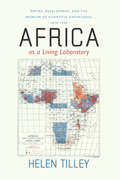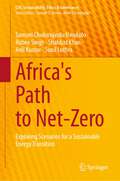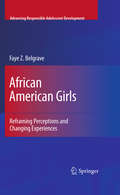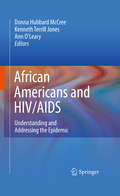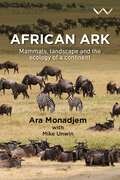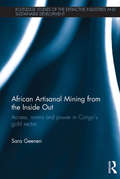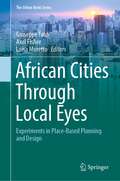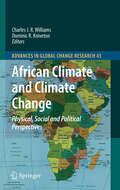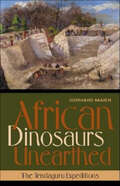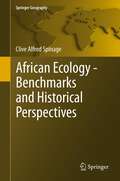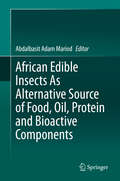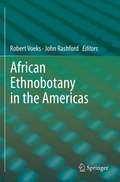- Table View
- List View
Affinity Chromatography: Methods and Protocols (Methods in Molecular Biology #2466)
by B. Vijayalakshmi Ayyar Sushrut AroraThis volume covers various aspects of affinity chromatography along with examples of its applications. Chapters guide readers through methodologies to purify a diverse array of molecular targets such as antibodies, extracellular vesicles, recombinant proteins, biomarkers, metabolites, plant organelles, nucleic acids, ligand identification and protocols on building affinity matrix. Written in the format of the highly successful Methods in Molecular Biology series, each chapter includes an introduction to the topic, lists necessary materials and reagents, includes tips on troubleshooting and known pitfalls, and step-by-step, readily reproducible protocols. Authoritative and cutting-edge, Affinity Chromatography: Methods and Protocols aims to be an invaluable resource to anyone employing affinity chromatography-based methodologies.
Affinity Chromatography: Methods and Protocols (Methods in Molecular Biology #421)
by Michael ZachariouThirty-eight years after its introduction, affinity chromatography remains a key tool in the armory of separation techniques available to separation and interaction scientists. Expanded and updated from the first edition, this second edition volume aims to provide the beginner with the practical knowledge needed to develop affinity separations suitable for a variety of applications relevant to the post-genomic era. It contains state-of-the-art, brand new protocols, and provides step-by-step laboratory instructions for readily reproducible results.
Affinity Chromatography: Template Chromatography of Nucleic Acids and Proteins
by Herbert SchottThis book informs the reader about the practical methods, possibilities, and limits of template chromatography. It shows the various techniques for immobilization of nucleic acids fragments, polynucleotides, and nucleic acids by which the desired separation of materials can be achieved.
Affinity Electrophoresis: Principles and Clinical Application
by Jan BreborowiczThis book discusses the topic of affinity electrophoresis (AFF-EP), which has become a useful tool for studies of biomolecular interactions. The book will discuss AFF-EP as an analytical method which has been used successfully for the diagnosis, differentiation, and monitoring of patients with various diseases. The book will also discuss other uses for the AFF-EP method.
Affinity Modification Of Biopolymers
by Dmitri G KnorreThe goal of this book is to give a systematic description of the main principles of affinity modification and applications, consideration of possibilities, and restrictions of the method. Modification within specific complexes is a special case of chemical modification which is widely used in the nonaddressed version in biochemistry and related areas. Therefore, we have included in the first introductory paper chapter of the book general considerations of chemical modifications of biopolymers and the application of biopolymers.
Affinity, That Elusive Dream: A Genealogy of the Chemical Revolution
by Mi Gyung KimMi Gyung Kim restores chemical affinity to its proper place in historiography and in Enlightenment public culture. The Chemical Revolution is usually associated with Antoine-Laurent Lavoisier, who introduced a modern nomenclature and a definitive text.
Afforestation, Reforestation and Forest Restoration in Arid and Semi-arid Tropics: A Manual of Technology & Management
by Panna Ram SiyagThe book is a comprehensive manual of practice for execution of afforestation and tree planting programmes in arid and semi-arid tropics. It includes a compact running account of the technology of afforestation and the relevant principles and practices in management of afforestation projects. It provides a wide range of structured information and a number of model designs which can be gainfully put to use by the field level supervisors as also by the managers concerned with planning and control of such projects. Written by a practising specialist, the book is invaluable for anyone concerned with the practice of afforestation and tree planting, be he a tree hobbyist or a school teacher, a professional forester or a senior policy maker in government, an industrialist or a philanthropist, an environmental activist or a member of a community service organization.
Aflatoxins & Human Health
by Ivana DvorackovaThis up-to-date reference includes the most recent available data and detailed case studies concerning the potential health risks of aflatoxin in the human population. It covers everything from acute toxic effects of aflatoxin in men to original observations concerning occupational health hazards due to aflatoxin exposure via the respiratory tract.
Aflatoxins in Food: A Recent Perspective
by Khalid Rehman Hakeem Carlos A. F. Oliveira Amir IsmailMycotoxins are the metabolites of fungus and are reported to contaminate nearly 25% of the food produced worldwide. The mycotoxins of most significance are the aflatoxins due to their severe health implications and their prevalence in food commodities on a larger scale. Aflatoxins are produced by certain species of fungi the most prominent among which are Aspergillus flavus, A. parasiticus and A. nominous. Food commodities of African and South Asian countries are especially reported to have aflatoxins well beyond the allowable limits but due to the global trade of food commodities developed countries are also prone towards the perils of aflatoxins. Moreover, climate changes may have a substantial impact on the distribution and global prevalence of aflatoxins in the near future.The International Agency for Research on Cancer (IARC) has classified the aflatoxins as group 1 category carcinogen. Aflatoxins are also reported as teratogenic, mutagenic, growth retardant, immunosuppressant and may also cause nervous system and reproductive system disorders. Preventive approaches involving good manufacturing from “farm to fork” are the major focus of the current food industry.The aim of our book is to provide readers with the most recent data and up-to-date studies from aflatoxins research, with specific focuses on (i) the impact of aflatoxins on human health, (ii) new approaches by the researchers from different parts of the world to degrade aflatoxins and (iii) potential preventive approaches that can significantly lessen the burden of aflatoxins in food products
Africa and the Sustainable Development Goals (Sustainable Development Goals Series)
by Maano Ramutsindela David MicklerThe book draws upon the expertise and international research collaborations forged by the Worldwide Universities Network Global Africa Group to critically engage with the intersection, in theory and practice, of the Sustainable Development Goals (SDGs) and Africa’s development agendas and needs. Further, it argues that – and demonstrates how – the SDGs should be understood as an aspirational blueprint for development with multiple meanings that are situated in dynamic and contested terrains. As the SDGs have substantial implications for development policy and resourcing at both the macro and micro levels, their relevance is not only context-specific but should also be assessed in terms of the aspirations and needs of ordinary citizens across the continent. Drawing on analyses and evidence from both the natural and social sciences, the book demonstrates that progress towards the SDGs must meet demands for improving human well-being under diverse and challenging socio-economic, political and environmental conditions. Examples include those from the mining industry, public health, employment and the media. In closing, it highlights how international collaboration in the form of research networks can enhance the production of critical knowledge on and engagement with the SDGs in Africa.
Africa as a Living Laboratory: Empire, Development, and the Problem of Scientific Knowledge, 1870–1950
by Helen TilleyTropical Africa was one of the last regions of the world to experience formal European colonialism, a process that coincided with the advent of a range of new scientific specialties and research methods. Africa as a Living Laboratory is a far-reaching study of the thorny relationship between imperialism and the role of scientific expertise—environmental, medical, racial, and anthropological—in the colonization of British Africa. A key source for Helen Tilley’s analysis is the African Research Survey, a project undertaken in the 1930s to explore how modern science was being applied to African problems. This project both embraced and recommended an interdisciplinary approach to research on Africa that, Tilley argues, underscored the heterogeneity of African environments and the interrelations among the problems being studied. While the aim of British colonialists was unquestionably to transform and modernize Africa, their efforts, Tilley contends, were often unexpectedly subverted by scientific concerns with the local and vernacular. Meticulously researched and gracefully argued, Africa as a Living Laboratory transforms our understanding of imperial history, colonial development, and the role science played in both.
Africa's Path to Net-Zero: Exploring Scenarios for a Sustainable Energy Transition (CSR, Sustainability, Ethics & Governance)
by Shahbaz Khan Anil Kumar Sunil Luthra Samuel Chukwujindu Nwokolo Rubee SinghThis book provides a comprehensive analysis of the challenges and opportunities for achieving a net-zero energy transition in Africa. With a focus on policy, technology, financing, and socio-political factors, the book presents four potential scenarios for a sustainable energy transition in the continent. The scenarios presented highlight the importance of balancing economic growth with environmental sustainability and social development. While foreign investments in renewable energy could be beneficial, they must be carefully monitored and regulated to prevent exploitation and ensure accountability. The book also emphasizes the need for collaboration and a calculated transition to ensure that all stakeholders are involved in the process. Additionally, the challenges of achieving self-sufficiency and export-free energy are discussed, with the importance of setting limitations and regulations to prevent a vicious cycle of poverty and dependency on foreign aid. With a deep understanding of Africa's environmental, socio-political, and socio-cultural complexities, “Africa's Path to Net-Zero” offers valuable insights for policymakers, investors, and anyone interested in promoting a sustainable energy future for the continent.
Africa-EU Renewable Energy Research and Innovation Symposium 2018: 23–26 January 2018, National University of Lesotho On occasion of NULISTICE 2018 (Springer Proceedings in Energy)
by Moeketsi Mpholo Dirk Steuerwald Tonny KukeeraThis open access book presents the proceedings of the 2nd Africa-EU Renewable Energy Research and Innovation Symposium (RERIS 18), held in Maseru, Lesotho in January 2018. The symposium aimed to foster research cooperation on renewable energy between Africa and Europe – in academia, as well as the private and public sectors. Addressing thematic areas such as• Grid-connected renewable energy;• Decentralised renewable and household energy solutions;• Energy socioeconomics; and• Promotion of energy research, innovation, education and entrepreneurship,the book brings together contributions from academics and practitioners from the EU and Africa to enable mutual learning and knowledge transfer – a key factor in boosting sustainable development in the African renewable energy market. It also plays a significant role in promoting African renewable energy research, which helps to secure energy supply in both rural and urban areas and to increase generation capacities and energy system resilience. This book is an invaluable resource for academics and professionals across the renewable energy spectrum.
African American Girls: Reframing Perceptions and Changing Experiences (Advancing Responsible Adolescent Development)
by Faye Z. BelgraveThe teenage years can be exciting for girls, as they develop into young women and anticipate their future. For some, however, this developmental stage may be tempered by increased risks for teen pregnancy, school failure, and some health problems. African American Girls: Reframing Perceptions and Changing Experiences explores not only the challenges and stressors confronting this unique population, but also the strengths and resiliencies used to meet them. Examining prevailing trends while avoiding simplistic generalizations, the book is both descriptive (e.g., explaining similarities and differences with girls of other ethnicities and African-American boys in critical areas) and useful (e.g., providing concrete guidelines for professionals working to support prosocial development and prevent risky behaviors). This unique volume: addresses salient issues of self and identity, examines crucial domains, such as relationships, achievements and expectations, and issues that have a major impact on health and well-being, offers practical recommendations and resources for working with African-American girls during the period when life experiences and decisions are most likely to affect adult outcomes, discusses the lives of girls from diverse families, communities, and circumstances, explores the influences of family, peers, community, and cultural traditions, features sample activities for promoting positive development and includes quotations reflecting the perspectives of the girls in their own words. African American Girls is an essential resource for a wide range of professionals, including clinical, child, and school psychologists, counselors, therapists, and social workers. Whether one's specialty is prevention, intervention, education, or research, this book is a must-have volume.
African Americans and HIV/AIDS: Understanding and Addressing the Epidemic
by Ann O'Leary MPH Msw Kenneth Terrill Jones Donna Hubbard Mccree RphThe HIV/AIDS epidemic is burgeoning among African American men and women. Despite comprising only 13% of the population, 50% of new HIV diagnoses in 2004 were among African Americans. Among women and men who have sex with men (MSM), African Americans are grossly disproportionately affected by this epidemic, and this trend shows no sign of abating. This book seeks to explore some of the contextual factors that contribute to this disparity as well as ways to intervene to slow the growth of the epidemic in the U.S. This volume will focus on the history and context of HIV/AIDS in African Americans and interventions targeting specific sub-populations including adolescents, heterosexual men and women, men who have sex with men, incarcerated populations, and injection drug users. Context chapters will focus on specific contextual and structural issues related to HIV/AIDS transmission and prevention in African Americans including disparities in incarceration, racism, economic issues and substance abuse. Intervention chapters will focus on best-evidence and promising-evidence based interventions targeting HIV prevention in African Americans. These chapters will address the latest in intervention strategies, program evaluation, cost effectiveness and qualitative research methods and will include risk reduction, risk assessment, and testing and counseling.
African Ark: Mammals, landscape and the ecology of a continent
by Dr. Ara MonadjemThe story of how Africa’s mammals have helped shape the continent’s landscapes over time to support an amazing diversity of lifeAfrica is home to an amazing array of animals, including the world’s most diverse assortment of large mammals. These include the world’s largest terrestrial mammal, the African elephant, which still roams great swathes of the continent alongside a host of other well-known large mammals with hooves such as hippopotamuses, giraffes, rhinoceroses, and zebras. African Ark: Mammals, Landscape and the Ecology of a Continent tells the story of where these mammals have come from and how they have interacted to create the richly varied landscape that makes up Africa as we know it today. It gives an equal airing to small mammals, such as rodents and bats, which are often overlooked by both naturalists and zoologists in favor of their larger cousins. African Ark not only describes the diversity of African mammals and the habitats in which they live; it also explains the processes by which species and population groups are formed and how these fluctuate over time. A book on mammals would not be complete without attention placed on the impact of megafauna on the environment and the important roles they play in shaping the landscape. In this way, mammals such as elephants and rhinoceros support countless plant communities and the habitats of many smaller animals. The book brings in a human perspective as well as a conservation angle in its assessment of the interaction of African mammals with the people who live alongside them. African Ark is at once scientifically rigorous and accessible for the layperson and student alike, while drawing on the contributions of numerous zoologists, ecologists and conservationists dedicated to the understanding of Africa and its wildlife.
African Artisanal Mining from the Inside Out: Access, norms and power in Congo’s gold sector (Routledge Studies of the Extractive Industries and Sustainable Development)
by Sara GeenenArtisanal mining is commonly associated with violent conflict, rampant corruption and desperate poverty. Yet millions of people across Sub Sahara Africa depend on it. Many of them are living in eastern Democratic Republic of Congo (DRC), home to important mineral reserves, but also to a plethora of armed groups and massive human rights violations. African Artisanal Mining from the Inside Out provides a rich and in-depth analysis of the Congolese gold sector. Instead of portraying miners and traders as passive victims of economic forces, regional conflicts or disheartening national policies, it focuses on how they gain access to and benefit from gold. It shows a professional artisanal mining sector governed by a set of specific norms, offering ample opportunities for flexible employment and local livelihood support and being well-connected to the local economy and society. It argues for the viability of artisanal gold mining in the context of weak African states and in the transition towards a post-conflict and more industrialized economy. This book will be of great interest to researchers and postgraduates studying natural resources and development as well as those in development studies, African studies, sociology, political economy, political ecology, legal pluralism, and history.
African Cities Through Local Eyes: Experiments in Place-Based Planning and Design (The Urban Book Series)
by Giuseppe Faldi Axel Fisher Luisa MorettoThis book provides readers with a wide overview of place-based planning and design experiments addressing such powerful transformations in the African built environment. This continent is currently undergoing fast paced urban, institutional and environmental changes, which have stimulated an increasing interest for alternative architectural solutions, urban designs and comprehensive planning experiments. The international and balanced array of the collected contributions explore emerging research concepts for understanding urban and peri-urban processes in Africa, discuss bottom-up planning and design practices, and present inspirational and innovative co-design methods and participatory tools for steering such change through public spaces, sustainable services and infrastructures. The book is intended for students, researchers, decision-makers and practitioners engaged in planning and design for the built environment in Africa and the Global South at large.
African Climate and Climate Change: Physical, Social and Political Perspectives (Advances in Global Change Research #43)
by Charles J. Williams Dominic R. KnivetonCompared to many other regions of the world, Africa is particularly vulnerable to the effects of climate change and variability. Widespread poverty, an extensive disease burden and pockets of political instability across the continent has resulted in a low resilience and limited adaptative capacity of African society to climate related shocks and stresses. To compound this vulnerability, there remains large knowledge gaps on African climate, manifestations of future climate change and variability for the region and the associated problems of climate change impacts. Research on the subject of African climate change requires an interdisciplinary approach linking studies of environmental, political and socio-economic spheres. In this book we use different case studies on climate change and variability in Africa to illustrate different approaches to the study of climate change in Africa from across the spectrum of physical, social and political sciences. In doing so we attempt to highlight a toolbox of methodologies (along with their limitations and advantages) that may be used to further the understanding of the impacts of climate change in Africa and thus help form the basis for strategies to negate the negative implications of climate change on society.
African Dinosaurs Unearthed: The Tendaguru Expeditions (Life of the Past)
by Gerhard MaierFrom 1907 to 1931 at Tendaguru, a remote site in present-day Tanzania, teams of German (and later British) paleontologists unearthed 220 tons of fossils, including the bones of a new dinosaur, one of the largest then known. For decades the mounted skeleton of this giant, Brachiosaurus, was the largest skeleton of a land animal on exhibit in the world. The dinosaur and other animal fossils found at Tendaguru form one of the cornerstones of our understanding of life in the Mesozoic era. Visited sporadically during the '30s and '40s, Tendaguru again became the site of scientific interest late in the 20th century. African Dinosaurs Unearthed tells the story of driven scientific adventurers working under difficult conditions and often paying the price with their health—and sometimes with their lives. Set against the background of a troubled century, the book reveals how scientific endeavors were carried on through war and political turmoil, and continue into the present day.
African Ecology: Benchmarks and Historical Perspectives (Springer Geography)
by Clive Alfred SpinageIn view of the rapidly changing ecology of Africa ,this work provides benchmarks for some of the major, and more neglected, aspects, with an accent on historical data to enable habitats to be seen in relation to their previous state, forming a background reference work to understanding how the ecology of Africa has been shaped by its past. Reviewing historical data wherever possible it adopts an holistic view treating man as well as animals, with accent on diseases both human and animal which have been a potent force in shaping Africa's ecology, a role neglected in ecological studies.
African Edible Insects As Alternative Source of Food, Oil, Protein and Bioactive Components
by Abdalbasit Adam MariodThe harvesting, processing and consumption of edible insects is one of the main keys to the sustainability of food chains on the African continent. Insects are the largest and most successful group of animals on the planet and it is estimated that they comprise 80% of all animals. This makes edible insects extremely important to the future survival of large populations across Africa and the world. Insects offer a complete animal protein that includes all 9 essential amino acids and are very competitive with other protein sources. They are also a good source of beneficial unsaturated fats, and many insects have a perfect Omega 3:6 balance. African Edible Insects As Alternative Source of Food, Oil, Protein and Bioactive Components comprehensively outlines the importance of edible insects as food and animal feed and the processing of insects in Africa. The text also highlights indigenous knowledge of edible insects and shows the composition and nutritional value of these insects, plus presents reviews of current research and developments in this rapidly expanding field. All of the main types of edible insects are covered, including their nutritional value, chemical makeup, and harvesting and processing details. The various preparation technologies are covered for each insect, as are their individual sensory qualities and safety aspects. A key aspect of this work is its focus on the role of insects in edible oils and gelatins. Individual chapters focus on entomophagy in Africa and the various key aspects of the continent's growing edible insect consumption market. As it becomes increasingly clear that the consumption of insects will play a major role in the sustainability of food chains in Africa, this work can be used as a comprehensive and up-to-date singular source for researchers looking for a complete overview on this crucial topic.
African Ethnobotany in the Americas
by Robert Voeks John RashfordAfrican Ethnobotany in the Americas provides the first comprehensive examination of ethnobotanical knowledge and skills among the African Diaspora in the Americas. Leading scholars on the subject explore the complex relationship between plant use and meaning among the descendants of Africans in the New World. With the aid of archival and field research carried out in North America, South America, and the Caribbean, contributors explore the historical, environmental, and political-ecological factors that facilitated/hindered transatlantic ethnobotanical diffusion; the role of Africans as active agents of plant and plant knowledge transfer during the period of plantation slavery in the Americas; the significance of cultural resistance in refining and redefining plant-based traditions; the principal categories of plant use that resulted; the exchange of knowledge among Amerindian, European and other African peoples; and the changing significance of African-American ethnobotanical traditions in the 21st century. Bolstered by abundant visual content and contributions from renowned experts in the field, African Ethnobotany in the Americas is an invaluable resource for students, scientists, and researchers in the field of ethnobotany and African Diaspora studies.
African Fermented Food Products- New Trends
by Abdalbasit Adam Mariod Abdel Moneim Elhadi SuliemanFermented foods play a major role in human nutrition and health, given the addition of flavor, improvement of texture, preservation against spoilage, and ease of digestion due to the fermentation process. This book provides information about the chemistry and bioactive compounds of African fermented food products, including their nutritional value and minor constituents. Chapters cover a wide range of topics, from the microorganisms involved in spontaneous fermentation to food safety considerations and quality assessment. The text can be used as a practical manual to better understand the nutritional and medicinal uses of various African fermented foods, as well as prepare recipes and product labels.
African Genesis
by Sally C. Reynolds Andrew GallagherThe discovery of the first species of African hominin, Australopithecus africanus, from Taung, South Africa in 1924, launched the study of fossil man in Africa. New discoveries continue to confirm the importance of this region to our understanding of human evolution. Outlining major developments since Raymond Dart's description of the Taung skull and, in particular, the impact of the pioneering work of Phillip V. Tobias, this book will be a valuable companion for students and researchers of human origins. It presents a summary of the current state of palaeoanthropology, reviewing the ideas that are central to the field, and provides a perspective on how future developments will shape our knowledge about hominin emergence in Africa. A wide range of key themes are covered, from the earliest fossils from Chad and Kenya, to the origins of bipedalism and the debate about how and where modern humans evolved and dispersed across Africa.
